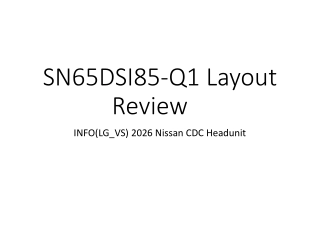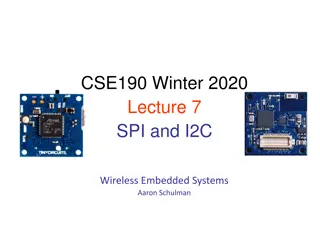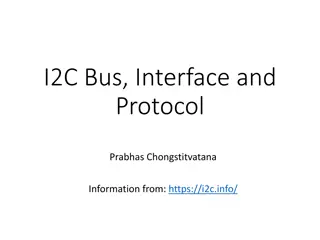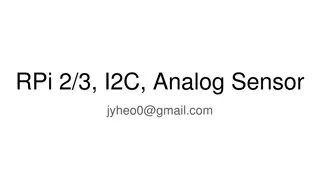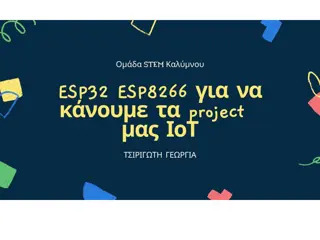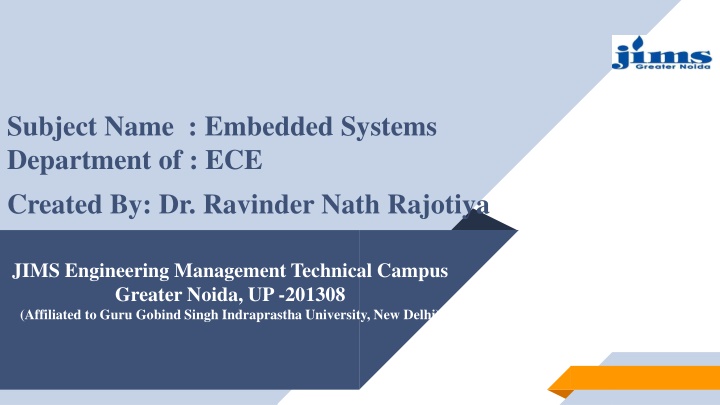
Introduction to Embedded Systems: I2C Communication Protocols
Discover the world of embedded systems with a focus on I2C communication protocols. Learn about ARM internal bus structures, the fundamentals of I2C mode of operation, and the significance of Direct Memory Access (DMA). Explore the LPC214X microcontroller and dive into the practical applications of the Inter-Integrated Circuit (I2C) in various electronic devices.
Download Presentation

Please find below an Image/Link to download the presentation.
The content on the website is provided AS IS for your information and personal use only. It may not be sold, licensed, or shared on other websites without obtaining consent from the author. If you encounter any issues during the download, it is possible that the publisher has removed the file from their server.
You are allowed to download the files provided on this website for personal or commercial use, subject to the condition that they are used lawfully. All files are the property of their respective owners.
The content on the website is provided AS IS for your information and personal use only. It may not be sold, licensed, or shared on other websites without obtaining consent from the author.
E N D
Presentation Transcript
Subject Name : Embedded Systems Department of : ECE Created By: Dr. Ravinder Nath Rajotiya JIMS Engineering Management Technical Campus Greater Noida, UP -201308 (Affiliated to Guru Gobind Singh Indraprastha University, New Delhi)
Subject : Embedded Systems Topic: : AMBA I2C
Outline Internal Bus structure of ARM Introduction to I2C Mode of Operation DMA
I2C (Inter Integrated Circuit) Philips Semiconductor (Now NXP Semiconductors) The Inter-Integrated Circuit (I2C) bus provides bi-directional data transfer through a two-wire design (a serial data line SDA and a serial clock line SCL). Application Areas: Can interface to external I2C devices such as serial memory (RAMs and ROMs), networking devices, LCDs, tone generators, and so on. The I2C bus may also be used for system testing and diagnostic purposes in product development and manufacturing. The TM4C123GH6PM microcontroller includes providing the ability to communicate (both transmit and receive) with other I2C devices on the bus. The TM4C123GH6PM controller includes I2C modules with the following features: Devices on the I2C bus can be designated as either a master or a slave Supports both transmitting and receiving data as either a master or a slave Supports simultaneous master and slave operation
I2C (Inter Integrated Circuit) Philips Semiconductor (Now NXP Semiconductors) It is a serial (two wire interface (TWI). It is also called as acknowledgment based communication protocol. I2C Modes of operation: Master Mode : Master is responsible for generating clock and initiating communication Slave Mode: Slave receives the clock and responds when addressed by the Master Two wires of the I2C interface SDA is Serial Data wire used for data transfer in between master and slave SCL is Serial Clock wire used for clock synchronization. Clock is provided by the master I2C Types of data transfer : Data transfer from Master Transmitter to Slave Receiver and Data transfer from Slave Transmitter to Master Receiver
LPC2148 has two I2C interfaces. i.e. I2C0 & I2C1 It has Programmable clock to support adjustable I2C transfer rates LPC2148 I2C is byte oriented and has four operating modes : Master Transmitter mode Master Receiver mode Slave Transmitter mode Slave Receiver mode
ARM7TDMI LPC214X PinOut SCL0: - Serial Clock pin of I2C0. SDA0: - Serial Data pin of I2C0. SCL1: - Serial Clock pin of I2C1. SDA1: - Serial Data pin of I2C1.
I2C Block diagram of ARM TM4c123GH 2C module 0 clock. Note that this signal has an active pull-up. The corresponding port pin should not be configured as open drain SDA: I2C data line
I2C Functional Description Each I2C module is comprised of both master and slave functions and is identified by a unique address. A master-initiated communication generates the clock signal, SCL. For proper operation, the SDA pin must be configured as an open-drain signal. Due to the internal circuitry that supports high-speed operation, the SCL pin must not be configured as an open-drain signal, although the internal circuitry causes it to act as if it were an open drain signal. Both SDA and SCL signals must be connected to a positive supply voltage using a pull- up resistor.
DMA Every transaction on I2C is 9-bit long consisting of eight data bits and a single acknowledge bit. The number of bytes per transfer (defined as the time between a valid START and STOP condition
START and STOP Conditions The protocol of the I2C bus defines two states to begin and end a transaction: START and STOP. A High-to-Low transition on the SDA line while the SCL is High is defined as a START condition, and a Low-to-High transition on the SDA line while SCL is High is defined as a STOP condition. 1st 7 bit are slave address Bit-8 Direction R/T: . A zero in the R/S position of the first byte means that the master transmits (sends) data to the selected slave, and a one in this position means that the master receives data from the slave Bit-9 Ack; A data transfer is always terminated by a STOP
Data Validity Data Validity The data on the SDA line must be stable during the high period of the clock, and the data line can only change when SCL is Low
Arbitration A master may start a transfer only if the bus is idle. It's possible for two or more masters to generate a START condition within minimum hold time of the START condition. In these situations, an arbitration scheme takes place on the SDA line, while SCL is High. During arbitration, the first of the competing master devices to place a 1 (High) on SDA, while another master transmits a 0 (Low), switches off its data output stage and retires until the bus is idle again. Arbitration can take place over several bits. Its first stage is a comparison of address bits, and if both masters are trying to address the same device, arbitration continues on to the comparison of data bits.
I2C Registers I2C0CONSET (I2C0 Configuration Set Register): I2C0CONCLR (I2C0 Configuration Clear Register) It is an 8-bit write only register. I2C0STAT (I2C0 Status Register) : It is an 8-bit read only register. It reflects the present status of the I2C interface I2C0DAT (I2C0 Data Register) : It is an 8-bit read-write register I2C0SCLL (I2C0 SCL Low Duty Cycle Register): It is a 16-bit register I2C0SCLH (I2C0 SCL High Duty Cycle Register) : It is a 16-bit register I2C0ADR (I2C0 Slave Address Register): It is an 8-bit read-write register.

